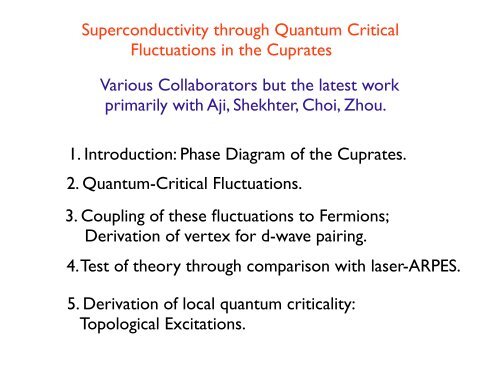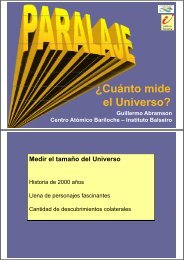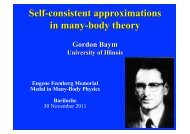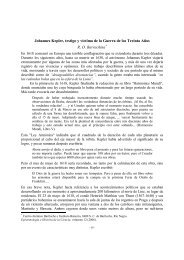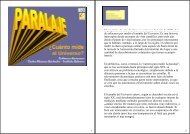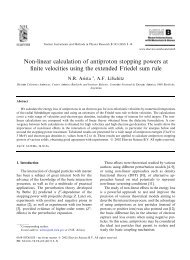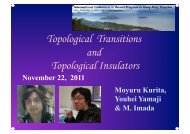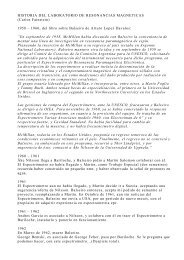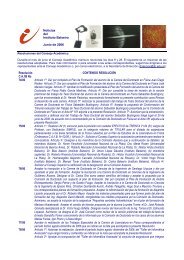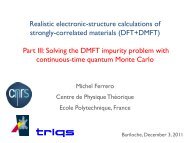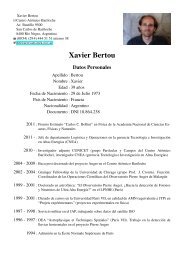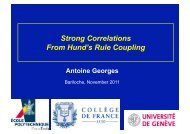Superconductivity through Quantum Critical Fluctuations in the ...
Superconductivity through Quantum Critical Fluctuations in the ...
Superconductivity through Quantum Critical Fluctuations in the ...
Create successful ePaper yourself
Turn your PDF publications into a flip-book with our unique Google optimized e-Paper software.
<strong>Superconductivity</strong> <strong>through</strong> <strong>Quantum</strong> <strong>Critical</strong><strong>Fluctuations</strong> <strong>in</strong> <strong>the</strong> CupratesVarious Collaborators but <strong>the</strong> latest workprimarily with Aji, Shekhter, Choi, Zhou.1. Introduction: Phase Diagram of <strong>the</strong> Cuprates.2. <strong>Quantum</strong>-<strong>Critical</strong> <strong>Fluctuations</strong>.3. Coupl<strong>in</strong>g of <strong>the</strong>se fluctuations to Fermions;Derivation of vertex for d-wave pair<strong>in</strong>g.4. Test of <strong>the</strong>ory <strong>through</strong> comparison with laser-ARPES.5. Derivation of local quantum criticality:Topological Excitations.
The phenomena <strong>in</strong> <strong>the</strong> Cuprates has required are-exam<strong>in</strong>ation of some of <strong>the</strong> fundamentalConcepts of Condensed Matter Physics.
Universal Phase DiagramTAntiferromagnetism?T*StrangeMetalCrossoverPseudo-GappedFermi liquidQCPx (dop<strong>in</strong>g)<strong>Superconductivity</strong>L<strong>in</strong>es drawn (1997) based on phenomena which occur <strong>in</strong>reasonably pure samples of all Cuprates.
TThis Region Violates Quasi-particleConcepts. <strong>Quantum</strong> <strong>Critical</strong><strong>Fluctuations</strong> with spatially localcriticality and ω/ T scal<strong>in</strong>g.↓T* CrossoverLoopordered.Fermi liquidQCPx (dop<strong>in</strong>g)<strong>Superconductivity</strong>
Fermi-Arc Phenomena:A New paradigm for massgeneration or gap formation.TAn anisotropic gap at chemical potentialwithout change of translational symmetry:T*StrangeMetalCrossoverFermi liquidQCPx (dop<strong>in</strong>g)
TT*StrangeMetalCrossoverPseudo-GappedFermi liquidQCPx (dop<strong>in</strong>g)This region has a scale of fluctuationsextend<strong>in</strong>g to ~0.4 eV, with preferred π/2scatter<strong>in</strong>g lead<strong>in</strong>g to high Tc <strong>in</strong> <strong>the</strong> d-wavechannel.
Any <strong>the</strong>oretical ideas and calculations whichdo not expla<strong>in</strong> <strong>the</strong> normal state propertiesis not a candidate for understand<strong>in</strong>gsuperconductivity ei<strong>the</strong>r.All <strong>the</strong> remarkable effects should followfrom a s<strong>in</strong>gle set of ideas.
TThis Region Violates Quasi-particleConcepts. <strong>Quantum</strong> <strong>Critical</strong><strong>Fluctuations</strong> with spatially localcriticality and ω/ T scal<strong>in</strong>g.↓T* CrossoverLoopordered.Fermi liquidQCPx (dop<strong>in</strong>g)<strong>Superconductivity</strong>
Effect of <strong>Fluctuations</strong> on S<strong>in</strong>gle-particleSpectra measured <strong>in</strong> ARPES15Im (⇤,k)(k)0d⇤ Im⇥(⇤ ) ⇥(k) =k| (k, k )| 2Predicts L<strong>in</strong>ewidth proportional to for cand constant beyond. Factor of ~ 2 mom. dependence.
Recent ARPES Experiments to High Energies.oXOP Bi2201 Nodal , Meevasana et al.OP-Bi2212 Nodal, Lanzara et al.LSCO OP, Nodal , Chang et al.LSCO Nodal underdoped, Chang etThis is an experimental proof of <strong>the</strong> existence of a dist<strong>in</strong>ctspectrum of fluctuations with a well-def<strong>in</strong>ed cut-off frequency.This is what couples to fermions at just above Tc.
If <strong>the</strong>re is a region of <strong>Quantum</strong>-critical <strong>Fluctuations</strong>,<strong>the</strong>re may be an unusual ordered phase?Universal Phase DiagramTAntiferromagnetism?T*StrangeMetalCrossoverPseudo-GappedFermi liquidQCPx (dop<strong>in</strong>g)<strong>Superconductivity</strong>
Loop OrderDerived (1997) <strong>in</strong> three orbital model for cuprates a time-reversalviolat<strong>in</strong>g state preserv<strong>in</strong>g translational symmetry. More detailedcalculations by Weber et al.Model has four possible flux configurations <strong>in</strong> a cell <strong>in</strong>to one of whichorder is observed.Order parameter:Cu+OCuO_CuOO CuL i = M i ˆr i L i | i = e i i| iθ= π/4, 3π/4, 5π/4, 7π/4.
s but simply characterized temperaturerties studied. Characteristic Fermi-liquidregion (II) an anisotropic gap (pseudoicalpotential is observed. Transport [?]racteristic changes below <strong>the</strong> l<strong>in</strong>e T p (x).erties across di erent l<strong>in</strong>es also occur. Itnd <strong>the</strong> universal properties.Experiments consistent with this long-range order.This order has been observed <strong>in</strong> four dist<strong>in</strong>ct families ofCuprates by Polarized Neutron scatter<strong>in</strong>g or by DichroicARPES.YBa(2)Cu(3)O(6+x)Bi2212HgBaCuOLSCO:IIIFermi liquidCrossoverx (dop<strong>in</strong>g)Temperature (K)4003002001000T (K)and discussed fur<strong>the</strong>r belowHg1201 are <strong>in</strong> good agreem400 <strong>in</strong> Figs. 1-5 demonstrate tha300netic signal belowysis method.T mag is <strong>in</strong>It is fur<strong>the</strong>rm200100crease of T ⇤ toward higher hoappearance of <strong>the</strong> pseudogapdop<strong>in</strong>g. Moreover, as alread00.05 0.1 0.15 0.2p0.05 0.1 0.15 0.2Hole dop<strong>in</strong>g player YBCO. 3,4,9 . These releast <strong>in</strong> compounds with higpseudogap phenomenon is aa mere crossover.In Ref. 4 an attempt wascal exponent of <strong>the</strong> transitiothat <strong>the</strong> fit value depends otr<strong>in</strong>sic temperature dependenconsidered <strong>in</strong> comparisons wof 2 =0.37±0.12 is consiste5). The uncerta<strong>in</strong>ty <strong>in</strong> <strong>the</strong>
<strong>Superconductivity</strong> <strong>through</strong> <strong>Quantum</strong> <strong>Critical</strong><strong>Fluctuations</strong> <strong>in</strong> <strong>the</strong> Cuprates1. Introduction: Phase Diagram of <strong>the</strong> Cuprates.2. <strong>Quantum</strong>-<strong>Critical</strong> <strong>Fluctuations</strong>.3. Coupl<strong>in</strong>g of <strong>the</strong>se fluctuations to Fermions;Derivation of vertex for d-wave pair<strong>in</strong>g.4. Test of <strong>the</strong>ory <strong>through</strong> comparison with laser-ARPES.5. Derivation of local quantum criticality:Topological Excitations.
For quantum-fluctuations <strong>in</strong> <strong>the</strong> disordered phase,one must consider a generator of rotations among <strong>the</strong>m.Generator of Rotations among <strong>the</strong> four configurations.L z,i | i = e i /4 | i + ⇥/2
current operators <strong>in</strong> <strong>the</strong> l<strong>in</strong>k (p, p + 1). Note that this is<strong>the</strong> lattice equivalent of transforms as (r ⇥ p), where rand p are <strong>the</strong> position and momentum vectors along <strong>the</strong>l<strong>in</strong>ks of <strong>the</strong> unit-cell.<strong>Quantum</strong>-<strong>Critical</strong> <strong>Fluctuations</strong> : Aji-cmv PRL(07); PR-B(09)OCuThe critical modes are <strong>the</strong> fluctuations among <strong>the</strong> fourconfigurations of observed order, i.e., among <strong>the</strong> fourorientations of <strong>the</strong> order parameter vector L.(a)(b)FIG. 1: a: The four doma<strong>in</strong>s of <strong>the</strong> circulat<strong>in</strong>g current phaseare shown. They may be specified by <strong>the</strong> four orientationsof a vector shown <strong>in</strong> red. b: Schematic representation of <strong>the</strong>current due to <strong>the</strong> operator C(j i )In <strong>the</strong> fluctuations regime <strong>the</strong> vector L has <strong>the</strong> same critical<strong>Quantum</strong> Ashk<strong>in</strong>-Teller model: In <strong>the</strong> quantum fluctuationregime, fluctuat<strong>in</strong>g flux and current patterns overany region of space and time are generated by <strong>the</strong> elementaryprocess of fluctuations between <strong>the</strong> four config-spectra as a model with a cont<strong>in</strong>uous rotations of L, i.e. <strong>the</strong>quantum- XY model.⇧ 0 maywhereof <strong>the</strong>cell.mate fr0.1µ B pCouppl<strong>in</strong>g ofa collecmatrix|⇥ i ± ⇤ter<strong>in</strong>g mtime-re<strong>the</strong> con<strong>in</strong> detaas <strong>the</strong>only userators<strong>the</strong> operotatiorotatesator <strong>in</strong>P (1234
<strong>Fluctuations</strong> of <strong>the</strong> pseudogap order <strong>in</strong> QC region:CuOCuOCuOOCu<strong>Quantum</strong>-critical Flucts: Topological excitations whosebasic units are local flips among <strong>the</strong>se configurations lead<strong>in</strong>gto loops of all sizes and shapes appear<strong>in</strong>g and disappear<strong>in</strong>g.
Above <strong>the</strong> QCP of <strong>the</strong> orderd Phase, (Aji and Varma, PR-B ’09, ’10)⇥(r, t; r t )=< L(r, t)L(r ,t) >= (r r )t(q, ⇥) = tanh(⇥/2T ), ⇥⇥ c c =2JI1tIm (k, ⇥)/TMarg<strong>in</strong>al Fermi-Liquid f<strong>in</strong>ally Derived from a Microscopic ModelTc
<strong>Superconductivity</strong> <strong>through</strong> <strong>Quantum</strong> <strong>Critical</strong><strong>Fluctuations</strong> <strong>in</strong> <strong>the</strong> Cuprates1. Introduction: Phase Diagram of <strong>the</strong> Cuprates.2. <strong>Quantum</strong>-<strong>Critical</strong> <strong>Fluctuations</strong>.3. Coupl<strong>in</strong>g of <strong>the</strong>se fluctuations to Fermions;Derivation of vertex for d-wave pair<strong>in</strong>g.4. Test of <strong>the</strong>ory <strong>through</strong> comparison with laser-ARPES.5. Derivation of local quantum criticality:Topological Excitations.
Fermion pair<strong>in</strong>g: An Important General Po<strong>in</strong>t(Miyake, Schmitt-R<strong>in</strong>k, V. (1986))k’-k’gFg: g 2 (k, k 0 )F (k, k 0 ,!)k-kSymmetry of Pair<strong>in</strong>g determ<strong>in</strong>ed by Angular distribution ofscatter<strong>in</strong>g from k to k’:S-wave: isotropic scatter<strong>in</strong>g of fermions.P-wave: preferred forward (near 0-angle) and backward(near ∏ ) scatter<strong>in</strong>g of fermions.D-wave: preferred scatter<strong>in</strong>g at +/- (π /2) .
angle <strong>in</strong>dependence of <strong>the</strong> Eliashberg function 2 F,,i.e., <strong>the</strong> angle averaged product of <strong>the</strong> matrix element and <strong>the</strong>spectral function of <strong>the</strong> fluctuations, as def<strong>in</strong>ed <strong>in</strong> Eq. 13,<strong>the</strong> possible physics of <strong>the</strong> low-energy bump around0.05 eV, <strong>the</strong> vertex corrections to <strong>the</strong> Eliashberg equation,and various o<strong>the</strong>r assorted issues. The f<strong>in</strong>d<strong>in</strong>g that <strong>the</strong> Eliashbergfunction is angle <strong>in</strong>dependent below <strong>the</strong> cutoff c putsan important constra<strong>in</strong>t on <strong>the</strong> microscopic understand<strong>in</strong>g of<strong>the</strong> cuprates. For example, it can put a limit on <strong>the</strong> correlationlength for <strong>the</strong> commonly assumed form of <strong>the</strong> antiferromagneticAF fluctuations. A phenomenological form of<strong>the</strong> overdamped AF fluctuations may be written as 2,30How can a locally critical spectra give angle-dependentscatter<strong>in</strong>g?It can only do so due to <strong>the</strong> momentum dependenceof <strong>the</strong> vertex g(k,k’).This is <strong>in</strong> contrast with coupl<strong>in</strong>g <strong>through</strong> AFM fluctuations<strong>through</strong> Hubbard or t-J model, (or cdw or stripes) where <strong>the</strong>vertex is proportional to AF k,k, =U 2 (k k 0 ,!) 2 / AFk − k − Q 2 2 +1 2 + / AF 2 . 18 AF , can be obta<strong>in</strong>ed after <strong>the</strong> <strong>in</strong>tegral over with bothk and k on <strong>the</strong> Fermi surface, that is,±⇡/2This also gives scatter<strong>in</strong>g peaked at angle<strong>in</strong> a square lattice ifQ ⇡ (⇡, ⇡)and AF , = AF k,k, ,k F ⇠>>1We will be able to dist<strong>in</strong>guish between <strong>the</strong> two19where k and k have <strong>the</strong> angle and with respect to <strong>the</strong>from <strong>the</strong> experimental results.nodal cut, respectively. A straightforward calculation revealshigh-region orWerectionThe ek,qAs disc0.2 eV,only to8 is on<strong>the</strong>refortex corrconclustuationfrequenwhich i<strong>the</strong> uppbandwicorrecticlusionOne
Coupl<strong>in</strong>g of <strong>Quantum</strong>-critical fluctations to fermions.Aji, Shekhter, cmv (PRB-2010)In cont<strong>in</strong>uum limit, L z (r) is <strong>the</strong> angular momentumoperator for collective modes.It couples to <strong>the</strong> angular momentum operator forfermions:+ (r)(r p) (r)H coupl / L z (kk 0 ) + k 0 (ik ⇥ k 0 ) kk-k’k k’Orbital Moment Analog of <strong>the</strong> familiar coupl<strong>in</strong>g:J⇥ +k⇥ k · S
Pair<strong>in</strong>g VertexScatter<strong>in</strong>g <strong>through</strong> π/2 favoredk’-k’ik k ik k: g 2 (k ⇥ k 0 ) 2 hLLi(k, k 0 ,!)k-kProject to different angular momentum channels|k × k ′ | 2 =1/2(k 2 x + k 2 y)(k → k ′ ) − 1/2(k 2 x − k 2 y)(k → k ′ ) − 1/2(2k x k y )(k → k ′ ).Repulsive <strong>in</strong> s-wave channel, equally attractive <strong>in</strong>d(x 2 y 2 ) and d(xy) channels.
<strong>Superconductivity</strong> <strong>through</strong> <strong>Quantum</strong> <strong>Critical</strong><strong>Fluctuations</strong> <strong>in</strong> <strong>the</strong> Cuprates1. Introduction: Phase Diagram of <strong>the</strong> Cuprates.2. <strong>Quantum</strong>-<strong>Critical</strong> <strong>Fluctuations</strong>.3. Coupl<strong>in</strong>g of <strong>the</strong>se fluctuations to Fermions;Derivation of vertex for d-wave pair<strong>in</strong>g.4. Test of <strong>the</strong>ory <strong>through</strong> comparison with laser-ARPES.5. Derivation of local quantum criticality:Topological Excitations.
Deduc<strong>in</strong>g <strong>the</strong> Fluctuation Spectra Coupl<strong>in</strong>g to Fermions andLead<strong>in</strong>g to Pair<strong>in</strong>g <strong>in</strong> Cuprates from High-Resolution ARPES DataGeneralization of <strong>the</strong> MacMillan-Rowell procedureto d-wave Superconductors.Data from <strong>the</strong> Group of X<strong>in</strong>gjiang Zhou, Beij<strong>in</strong>gAnalysis done <strong>in</strong> collaboration with <strong>the</strong> group ofHan-Yong Choi, Seoul, Korea.This work is ongo<strong>in</strong>g.
MacMillan-Rowell ProcedurePair<strong>in</strong>g dynamicsBased on Eliashberg formulation of Pair<strong>in</strong>g withretarded <strong>in</strong>teractions and Schrieffer-Scalap<strong>in</strong>o-Wilk<strong>in</strong>s! For LTS: McMillan-Rowell <strong>in</strong>version ofconductance of S/I/N or S/I/S (1965).use of that <strong>the</strong>ory for Tunnel<strong>in</strong>g spectra.Pair<strong>in</strong>g dynamics! For LTS: McMillan-Rowell <strong>in</strong>version ofconductance of S/I/N or S/I/S (1965).! Fit by <strong>in</strong>vert<strong>in</strong>g<strong>the</strong> Eliashberg eq.to extract and .! Fit by <strong>in</strong>vert<strong>in</strong>g<strong>the</strong> Eliashberg I eq.to extract and .V
dI/dV ⇥ SdI/dV ⇥ N( )2 F (⇥)
Ord<strong>in</strong>ary Tunnel<strong>in</strong>g measurements: not useful forf<strong>in</strong>ite angular momentum pair<strong>in</strong>g.But ARPES can be used <strong>in</strong> this case.Procedure suggested : (Vekhter and cmv (2002))Extract from <strong>the</strong> data us<strong>in</strong>g Eliashberg Equations:XF`(k, !) ⌘ g 2 (k, k 0 )F (k, k 0 ,!)P`(k 0 )k 0Need to deduce bothF 0 (k, !) and F 2 (k, !)Requirements on <strong>the</strong> data are very severe.The requirements are beg<strong>in</strong>n<strong>in</strong>g to be met.Must also check <strong>the</strong> validity of <strong>the</strong> Eliashberg Equations
High Resolution Laser ARPES data. Zhou et al., Beij<strong>in</strong>g.Analysis: Choi, CV, Zhoubend<strong>in</strong>g back dispersion. (a1)-(f1). Orig<strong>in</strong>al photoemissionnodal and anti-nodal. (a2)-(f2). The correspond<strong>in</strong>g imageat 107K.
of Figs. 7 and 8 where <strong>the</strong> position of <strong>the</strong> band bottom withrespect to <strong>the</strong> Fluctuation Fermi energy spectra is given. just Theabove latter isTc.about 1 eV<strong>in</strong> <strong>the</strong> nodal Slighty direction underdoped and about 0.25 Sample eV at 25°. Bi2212. As wasshown <strong>in</strong> aInversion simple calculationus<strong>in</strong>g Elaishberg 27 and as ismethod:natural, <strong>the</strong> bandbottom serves as an effective cutoff <strong>in</strong> <strong>the</strong> fluctuation spectrumwhenno it iso<strong>the</strong>rlower<strong>the</strong>oretical than <strong>in</strong>tr<strong>in</strong>sicimput.cutoff. So one im-GUIDES TOIn this section, wewhich po<strong>in</strong>t to futureA peak carry<strong>in</strong>g10% of spec. wt.BOK et al.A featureless angle<strong>in</strong>d. (MFL) spectrawith rest of weight.Cut-off is smaller ofabout 0.4eVor bottom of bandPHYSICAL REVIEW B 81, 174516 2010FIG. 7. Color onl<strong>in</strong>e The Eliashberg function extracted from<strong>the</strong> real part of <strong>the</strong> self-energy at T=107 K. Notice <strong>the</strong> remarkablecollapse of <strong>the</strong> Eliashberg functions below 0.2 eV for differenttilt angles.FIG. 6. Color onl<strong>in</strong>e Comparison between <strong>the</strong> real part of <strong>the</strong>self-energy and <strong>the</strong> MEM fitt<strong>in</strong>g of Eq. 11 for <strong>the</strong> tilt angles =0° and 15°. The squares are <strong>the</strong> extracted real part self-energy of174516-6FIG. 9. Color onli<strong>the</strong> imag<strong>in</strong>ary parts of thgiven for representativeoverall as expected.FIG. 8. Color onl<strong>in</strong>e The angle dependence of <strong>the</strong> Fermi velocityand band bottom calculated from Eq. 4.
The Eliashberg functionAnalysis on an overdoped sample with Tc = 64 KBoth sample data are consistent with a fluctuation spectrawhich is q <strong>in</strong>dependent and matrix elements which areq-dependent.Consistency of analysis;Tc calculated backwards from spectra <strong>in</strong> <strong>the</strong> first caseis 105 K \pm 10K, Second case 88 \pm 10K,Expt. 91 K and 64 K.
erg function is angle <strong>in</strong>dependent below <strong>the</strong> cutoff c putsan important constra<strong>in</strong>t on <strong>the</strong> microscopic understand<strong>in</strong>g of<strong>the</strong> cuprates. For example, it can put a limit on <strong>the</strong> correlationlength for <strong>the</strong> commonly assumed form of <strong>the</strong> antiferromagneticAF fluctuations. A phenomenological form of<strong>the</strong> overdamped AF fluctuations by <strong>the</strong> form: may be written as 2,30AFM fluct. spectra or any o<strong>the</strong>r spectra specified by acorrelation lengthis ruled out. AF k,k, = 2 / AFk − k − Q 2 2 +1 2 + / AF 2 . 18 AF , can be obta<strong>in</strong>ed after <strong>the</strong> <strong>in</strong>tegral over with bothMOMENTUM DEPENDENCE OF THE SINGLE-PARTICLE…k and k on <strong>the</strong> Fermi surface, that is,1.00.8 AF , = AF k,k,⇥ = a, , =0, 5, .., 2519where k and0.6k have <strong>the</strong> angle and with respect to <strong>the</strong>nodal cut, respectively. A straightforward = a/⇥ calculation revealsΧAFΘ,Ω0.4that a weak dependence of AF , means that /a10.2for AF , where AF is <strong>the</strong> characteristic AF energy scale.0.0This is shown 0<strong>in</strong> Fig. 1 10 for 2 /a=1/ 3 4 with5<strong>the</strong> blue and for/a=1 with <strong>the</strong> red l<strong>in</strong>es. ΩΩFor AF each , <strong>the</strong> angles are =0° ,5° ,10° ,15° ,20° ,25° from above. As expected,FIG. 10. Color onl<strong>in</strong>e The model Eliashberg function calculated, from becomes <strong>the</strong> overdamped angle <strong>in</strong>dependent as is decreased. The AFcollapse of 2 AF fluctuations of Eq. 18. The red andblue l<strong>in</strong>es are forF, <strong>the</strong> AF correlation implieslength that/a=1 if it and is due 1/, to respec- <strong>the</strong> AF fluc-As discuss0.2 eV, thatonly to <strong>the</strong>8 is only a<strong>the</strong>refore fotex correcticonclusionstuation spefrequencywhich PHYS <strong>in</strong> d<strong>the</strong> upper cbandwidthcorrectionsclusions haOne f<strong>in</strong>aduced specfor <strong>the</strong> supparticle sel<strong>the</strong>n followof <strong>the</strong> fluctof <strong>the</strong> supestudy of thAn angle-<strong>in</strong>dependentquantum-critical spectra hyliquid description ofmicroscopically 31,32 to beregion of <strong>the</strong> phase diagratum melt<strong>in</strong>g of <strong>the</strong> loopunderdopedregion of <strong>the</strong> cdeduced 2 F, which<strong>the</strong> low-energy bump atpresence of this bump maIm , which is notT. The l<strong>in</strong>earity may<strong>the</strong>ory and earlier ARPESnot have <strong>the</strong> high resolutTc < 10 K for correlation length of a lattice constant.
How could one imag<strong>in</strong>e superconductivity from AFMfluctuations when AFM corr. length goes down whileTc is <strong>in</strong>creas<strong>in</strong>g?VOLUME 82, NUMBER 26 P H Y S I C A L R E V I E W L E T T EFIG. 1. q width (closed circles) and T C (open squares) versusoxygen content. FIG. 2. Supercofull square corres
SummaryMotivation: Attempt to understand all Anomalies <strong>in</strong> <strong>the</strong>Cuprates <strong>through</strong> a s<strong>in</strong>gle set of ideas.Loop Order at low carrier density.Collective modes of <strong>Fluctuations</strong> of loop orderhave local quantum-criticality to give Marg<strong>in</strong>al Fermi-liquid.Vertex coupl<strong>in</strong>g <strong>the</strong>se to fermions promotes d-wavepair<strong>in</strong>g with some unique signatures.Verification <strong>through</strong> quantitative comparison with highresolution ARPES data.Expect results on o<strong>the</strong>r samples with systematic variationof Tc and deduced spectra.
T<strong>Quantum</strong>-critical fluctuationsof <strong>the</strong> Loop Ordered Stateand a Marg<strong>in</strong>al fermi-liquidAntiferromagnetism?T*CrossoverA l<strong>in</strong>e ofphase transitions.Fermi liquidLoop-ordered Stateend<strong>in</strong>g at a QCP.Anisotropic gap atchem. potential.x (dop<strong>in</strong>g)QCP<strong>Superconductivity</strong>High Tc d-wave superconductivitydue to large freq. scale of qtm.crit.fluctuations and π/2 scatter<strong>in</strong>g due to<strong>the</strong> 4 configs. <strong>in</strong> loop-ord. state.
From New Yorker - April 25, 2011
<strong>Quantum</strong> <strong>Critical</strong> <strong>Fluctuations</strong>(Vivek Aji, cmv : PRL 07, PRB-09, PRB-10)Classical model:is equivalent <strong>in</strong> critical properties to a generalized xy model orInteract<strong>in</strong>g Rotors Model with anisotropy:The anisotropy is marg<strong>in</strong>ally irrelevant <strong>in</strong> <strong>the</strong> fluctuation regime but strongly relevant <strong>in</strong> <strong>the</strong>ordered phase. The model has no diverg<strong>in</strong>g specfic heat at <strong>the</strong> transition.+<strong>Quantum</strong> Generalization of <strong>the</strong> Model:Dissipative xy or <strong>Quantum</strong>-Rotor Modelexp(i i ) L + i :L is <strong>the</strong> angular momentum operator for <strong>the</strong> Rotors.H = L z i 2 /2I + J(L + i L j+ h.c.)+ Dissipative terms ( ).This model has been suggested to have a <strong>Quantum</strong> <strong>Critical</strong> Po<strong>in</strong>t at(Chakravarty, Kivelson, Lu<strong>the</strong>r, Ingold, Zimanyi, M. Fisher, .... )α = α c .
Theory of <strong>Critical</strong>ity2D XY model with dissipationS = ⇥ d⇤ij⇥ J cos (⇥ i ⇥ j )+ ⇥ d⇤i˙2C + ⇥ dkd⌅ |⌅| k 2 |⇥ k,⇥ | 2Exact Transformation <strong>in</strong> terms of two sets of orthogonal variables:S= d⇤drdr J⇥ v (r, ⇤)⇥ v (r , t)ln |r r |+ drd⇤d⇤ ⇥ w (r, ⇤)⇥ w (r, ⇤ )ln |⇤ ⇤ |S<strong>in</strong>gularities decouple <strong>in</strong> space and timeFluctuation spectrumIm (k, ⇥)/TTc
t f<strong>in</strong>ite temperature where <strong>the</strong> correlation funcder-parameterphase. Never<strong>the</strong>less e ı changes a from phaseexponential transitiontoPr<strong>in</strong>cipal Steps:temperature where <strong>the</strong> correlation funcarametere ı changes from exponential totransition. The quantum dissipative generalizatiomodel <strong>in</strong>cludes two dynamical terms and is given bpower law. This is <strong>the</strong> Kosterlitz-Thoulesstransition. 25,26 The quantum dissipative generalizmodel <strong>in</strong>cludes two dynamical terms and is giveZ = D i exp − 0= Z D i exp − 0S diss =−d0did ij,klC2 2 ij − J cos ij − klij,kl ij − kl ij,kl − ij − kl − + S diss ,e capacitance andS=R Q /R, where R Q =h/4e 2 .cs of this phase transition diss d ,=−isd0better understoodij,kl<strong>in</strong> terms of <strong>the</strong> − topological defects of <strong>the</strong> system. To dndard procedure of us<strong>in</strong>g <strong>the</strong> Villa<strong>in</strong> transform and <strong>in</strong>tegrat<strong>in</strong>g out <strong>the</strong> phase degrees of freedom. 20 Thacitance olves expand<strong>in</strong>g Villa<strong>in</strong> =R Transformation:<strong>the</strong> Q periodic /R, where function R Q =h/4e <strong>in</strong> terms 2 . of a periodic Gaussianthis phase transitionexp − J is better understood 1 − cos ij − kl <strong>in</strong> termsij,klm ij;klexp − of J <strong>the</strong> topological defects of ij − kl − 2m ij;kl /2 2 ,<strong>the</strong> system. Tprocedure of us<strong>in</strong>g <strong>the</strong> Villa<strong>in</strong> transform and <strong>in</strong>tegrat<strong>in</strong>g out <strong>the</strong> phase degrees of freedom. 20ij,klre <strong>in</strong>tegers that live on <strong>the</strong> l<strong>in</strong>ks of <strong>the</strong> orig<strong>in</strong>al. We can comb<strong>in</strong>e <strong>the</strong> two l<strong>in</strong>k variables m i,j;i+1,jto one <strong>in</strong>tegrated two-component over. vector m i,j that lives onof <strong>the</strong> lattice see Fig. 1. We expand <strong>the</strong> quadtransform to Fourier space. Keep<strong>in</strong>g <strong>the</strong> lead-diC2 2 ij − J cos ij − kl xy − x+1,y − 2m xx,y+ S diss ,2 ij − kl − ij − kl 2expand<strong>in</strong>g <strong>the</strong> periodic function <strong>in</strong> terms of a periodic Gaussianexp − J ij,kl1 − cos ij − kl m ij;klexp − J ij − kl − 2m ij;kl /2 2 ,ij,klNow <strong>the</strong> model is Gaussian <strong>in</strong> <strong>the</strong>θ’swhich can be, 2 a 2 2 xx xy +4a x xy m x,yxwhere m x,y is <strong>the</strong> x component of <strong>the</strong> vector field<strong>the</strong> <strong>in</strong>teger m . In <strong>the</strong> absence of dissipation,egers that live on <strong>the</strong> l<strong>in</strong>ks of <strong>the</strong> orig<strong>in</strong>al − − 2m x 2 a 2 2 +4a m x+
2 2where m x,y is <strong>the</strong> x component of <strong>the</strong><strong>the</strong> <strong>in</strong>teger m x,y;x+1,y . In <strong>the</strong> absence ofcompetition between <strong>the</strong> k<strong>in</strong>etic-energenergy terms, <strong>the</strong> former m<strong>in</strong>imized bydisordered stabiliz<strong>in</strong>g an <strong>in</strong>sulat<strong>in</strong>g phm<strong>in</strong>imized by a fixed value of ij staductor. S<strong>in</strong>ce ’s are bosonic degrees ofimpose <strong>the</strong> boundary condition that ij odicity <strong>in</strong> <strong>the</strong> imag<strong>in</strong>ary-time directionof <strong>the</strong> field ij implies that <strong>the</strong>re is anfreedom that has to be accounted for wnumber. At T=0, <strong>the</strong> imag<strong>in</strong>ary- tim<strong>in</strong>f<strong>in</strong>ite <strong>in</strong> extent, and <strong>the</strong> nondissipatthree-dimensional 3D XY universalitycretize <strong>the</strong> imag<strong>in</strong>ary-time direction <strong>in</strong>on a three-dimensional lattice. Introduwhich only live on <strong>the</strong> spatial l<strong>in</strong>ks, <strong>the</strong>disordered stabiliz<strong>in</strong>g and m i,j;ij+1 <strong>in</strong>to onean two-component <strong>in</strong>sulat<strong>in</strong>g vector m i,j phase that lives on while <strong>the</strong> latter<strong>the</strong> site i, j of <strong>the</strong> lattice see Fig. 1. We expand <strong>the</strong> quadraticatermfixed and transform value to Fourier ofspace. Keep<strong>in</strong>g <strong>the</strong> lead-xm<strong>in</strong>imized by<strong>in</strong>g quadratic term i,j − i+1,j −a x xy , where ij stabiliz<strong>in</strong>g a superconductor.m is S<strong>in</strong>ce a discretea is <strong>the</strong> latticeconstant, ’s are x=ai<strong>in</strong>teger bosonic and y=aj, we getfield degrees which of freedom, lives on we l<strong>in</strong>ks. need toimpose <strong>the</strong> boundary condition that ij = ij 0. The periodicity<strong>in</strong> <strong>the</strong> imag<strong>in</strong>ary-time i, j+y direction and <strong>the</strong> compactnessof <strong>the</strong> field ij implies that <strong>the</strong>re is an additional degree ofm i,j;i,j+ym mfreedom that has to bei-x,accountedj; i, ji, j; i+x, jfor which is <strong>the</strong> w<strong>in</strong>d<strong>in</strong>gi-x, ji, j i+x, jnumber. At T=0, <strong>the</strong> imag<strong>in</strong>ary- time direction becomesm i ,j-y; i, j<strong>in</strong>f<strong>in</strong>ite <strong>in</strong> extent, and <strong>the</strong> nondissipative model is <strong>in</strong> <strong>the</strong>three-dimensional 3D XY i-x, j-y universality class. First we discretize<strong>the</strong> imag<strong>in</strong>ary-time direction <strong>in</strong> units of and workZ = exp(a)on a three-dimensional lattice. Introduc<strong>in</strong>g <strong>the</strong> variables m k, mwhich only live on <strong>the</strong> spatial l<strong>in</strong>ks, <strong>the</strong> action is 19,20After <strong>in</strong>tegrat<strong>in</strong>g over <strong>the</strong> sZ = mm i,j;i,j+yexpk,m i, j; i+x, j− 4 2 J(b)FIG. 1. Color onl<strong>in</strong>e The directed l<strong>in</strong>k variables are labeled asshown <strong>in</strong> <strong>the</strong> 2 a. b We def<strong>in</strong>e a two-component vector liv<strong>in</strong>g on<strong>the</strong> sites of <strong>the</strong>m orig<strong>in</strong>al · mC/c lattice whose + components k 2 /are <strong>the</strong> two directedl<strong>in</strong>ks variables: m=m i,j;i+x,j ,m i,j;i,j+x . n m ijJck m 2C/c n 2 + Jck 2 + n k 2− 4 2 J nC/c 2 n + Jck 2 + n k 2,174501-2− 4 2 JckJC/c 2 n +− 4 2 J 2 nm · mC/c + k 2 / nC/c 2 n + Jck 2 + n where c=a/, J→Ja 2 , C→Ca 2 /have also redef<strong>in</strong>ed →a 3 . The last tetor is unimportant and may be dropped.has two possible phase transitions, depecapacitance C or <strong>the</strong> dissipation term <strong>the</strong> second term <strong>in</strong> Eq. 5 dom<strong>in</strong>ates <strong>in</strong>low-frequency limit. The former correswith <strong>the</strong> dynamic critical z=1, i.e., we5
ppose we separate m <strong>in</strong>to <strong>the</strong> usual transverse parms of a vortex field v k, n s of a vortex field v k, n Vortex field:ik m t k, n = v k, n ik m t k, n = v k, n d a longitud<strong>in</strong>al part <strong>through</strong> <strong>in</strong>troduc<strong>in</strong>g <strong>the</strong> wak,Split m <strong>in</strong>to its transverse and longitud<strong>in</strong>al parts:a longitud<strong>in</strong>al part <strong>through</strong> <strong>in</strong>troduc<strong>in</strong>g <strong>the</strong> w,Warp field: n m k, n = ckˆ w k, n . n m k, n = ckˆ w k, n .uite miraculously <strong>the</strong> partition function <strong>in</strong> Eq. 5 canritten exactly asThen one f<strong>in</strong>ds that <strong>the</strong> s<strong>in</strong>gular part of <strong>the</strong> action decouples as:e miraculously <strong>the</strong> partition function <strong>in</strong> Eq. 5 caexpn Z = J v , w k, k 2 vk n 2 −en exactly asS= d⇤drdr J⇥ v (r, ⇤)⇥ v (r , t)ln |r r |+ drd⇤d⇤ ⇥ w (r, ⇤)⇥ w (r, ⇤ )ln |⇤ ⇤ |Z = exp J 2 vk n 2 −J 2 k 24 wk n 2w k n 2
What is a “Warp”:A warp is an arrangement of <strong>the</strong> Divergence of a Field at a po<strong>in</strong>t is surrounded symmetricallyFor a general vector field oneby does expectoppositetwo k<strong>in</strong>ds of“charges” whose summed value is equal to <strong>the</strong> “charge”vortices, <strong>the</strong> additional topological entity to describe <strong>the</strong>at <strong>the</strong> center.FIG. 3: A phase slip between nearest neighbors <strong>in</strong> time producesa vortex and an antivortex on neighbour<strong>in</strong>g plaqiettes.In time one bond has acquired a nonzero value, representedby <strong>the</strong> red bond. If <strong>the</strong> value on <strong>the</strong> bond is -1, <strong>the</strong> vorticityat site 1 is negative and on site 2 is positive.ThereforeFIG. 4: A phase slipWarpsevent <strong>in</strong> rime resultshave<strong>in</strong> a changeno<strong>in</strong> <strong>the</strong><strong>in</strong>teractionssurrounded at <strong>the</strong>by four annearest equalneighbor butwithopposite sites. Incharge eachgeneraldistributed<strong>the</strong> magnitudeo<strong>the</strong>rl<strong>in</strong>k variables. For a change of 2π at site {i, j}, <strong>the</strong>fourl<strong>in</strong>ksof<strong>the</strong> divergence at <strong>the</strong> site will equal to <strong>the</strong> number of nearestconnected to it acquire <strong>the</strong> values shown <strong>in</strong> <strong>the</strong> figure.timeThusis a phase slip1/(τ-τ’).on a l<strong>in</strong>k is equivalentTheirto a localproliferation<strong>in</strong> are most one latticebelowspac<strong>in</strong>g apart; <strong>the</strong>a<strong>in</strong>teractioncrit. valueisoflocal <strong>in</strong> space. Although this is physically obvious fromdissipation gives <strong>the</strong> “local” quantum-critical fluctuationnext section.ρ i ps Θ (τ − τ i) [(̂x + ŷ) δ (r − r ij )spectra.Field configuration of a Warpspace and time vortex current.Local phase slips and WarpsThe periodic <strong>in</strong> time boundary condition allows forδτ− ŷδ (r − r ij − aŷ)] Θ (τ − τ i )Such a vector field distribution has no curl and hence doesnot effect <strong>the</strong> vorticity. On <strong>the</strong> o<strong>the</strong>r hand <strong>the</strong> divergencei.e. an arrangement ofδτmonopoles <strong>in</strong> which <strong>the</strong> “charge”is nonzero and phase slip events generate field configurationsthat are orthogonal to those created by vortices.sources to generate an arbitrary distribution. For <strong>the</strong>2+1 dimensional quantum model we have, besides <strong>the</strong>w<strong>in</strong>d<strong>in</strong>g number sector <strong>in</strong> time. Events that change <strong>the</strong>w<strong>in</strong>d<strong>in</strong>g number sector, i.e. local phase slips, acts assources for a divergence <strong>in</strong> <strong>the</strong> vector field. Just as avortex is equivalent to an electric charge <strong>in</strong> <strong>the</strong> dual language,<strong>the</strong> sources created by phase slips can be shownto be a local distribution of monopoles (ρ m ). Given <strong>the</strong>“Charge” configuration of a Warpdistribution <strong>in</strong> eqn.15, <strong>the</strong> correspond<strong>in</strong>g configuration ofmonopoles, which we term <strong>the</strong> charge of <strong>the</strong> phaseslip isρ m (r, τ) = ∇ · m(r, τ) (16)= [4δ (r − r ij ) − δ (r − r ij + âx)− δ (r − r ij − âx) − δ (r − r ij + aŷ)− δ (r − r ij − aŷ)] Θ (τ − τ i )The monopole distribution equivalent to a phaseslip isshown <strong>in</strong> fig.5. The total monopole charge of <strong>the</strong> configurationis zero. S<strong>in</strong>ce <strong>the</strong> distribution has azimuthalFIG. 5: Warps are configurations of <strong>the</strong> field m with f<strong>in</strong>itesymmetry all harmonics are zero. This is <strong>the</strong> two dimensionallattice {i, j}, <strong>the</strong> realization divergenceof has <strong>the</strong>a configuration magnitude of 4 of at a<strong>the</strong> charge site anddivergence but no curl. For a warp of unit strength at site-1over a spherical shell of radius a <strong>in</strong> three dimensions. Themagnetic neighbors field due on <strong>the</strong> to <strong>the</strong> lattice. charges is conf<strong>in</strong>ed with<strong>in</strong> one<strong>in</strong> space. They come and go <strong>in</strong> time and <strong>the</strong>ir <strong>in</strong>teraction <strong>in</strong>unit cell around <strong>the</strong> site of <strong>the</strong> phase slip and is zero outside.Thus two phase slip events can <strong>in</strong>teract only if <strong>the</strong>ythis discussion, ∇×m t we (r, will τ) = demonstrate ρ v (r, τ) this explicitly <strong>in</strong> <strong>the</strong> (18)m l (r, τ) = ∑Phase slip events generateia local vortex current whichis divergenceless but has − âxδ f<strong>in</strong>ite (r − rcurl.ij − âx)−ŷδ (r − r ij − aŷ)]5In Fourier space we getm t (k, ω n ) = ıẑ × kk 2 ρ v (k, ω n )( ) 1 − e−ık x a ̂x +m l (k, ω n ) =ıωρ ps (k, ω n ) = ∑ iρ i pse −ık·r i−ıThe locality <strong>in</strong> space is reflfactors (1 − exp (−ık x a)) andk x a, k y a ≪ 1, to lead<strong>in</strong>g orderm l (k, ω n ) ≈ a (k x̂x +ω nThe two components of <strong>the</strong> fieonal to each o<strong>the</strong>r. Compar<strong>in</strong>gnent of m l generated by a phalength limit and a warp (eqn.portional to each o<strong>the</strong>r. In papartition function can be recas
Correlation function <strong>in</strong> <strong>the</strong> <strong>Quantum</strong> critical RegionVortices are conf<strong>in</strong>ed; <strong>the</strong>y do not contribute to <strong>the</strong> dynamics.Above <strong>the</strong> critical value , <strong>the</strong> “warps” proliferate and disorder <strong>the</strong>Velocity field. The correlation functions can be calculated exactly.Correlation function of <strong>the</strong> Order Parameter atPhysical Reason: Interactions of topological defects (warps)is spatially local and logarithmic <strong>in</strong> time.
Theory of <strong>the</strong> Loop OrderPhysics beyond <strong>the</strong> Hubbard ModelThree-Orbital Model with on-site and nearest neighbor Interactions.oocuUse Operator identity:Vn i n j = V/2 |J ij | 2 + n i + n j ).J ij = ic + i c j + H.C. ⇥ current operator <strong>in</strong> <strong>the</strong> l<strong>in</strong>k (i j)SupposeV2 < J ij >= x ij .Then effective k<strong>in</strong>etic energy parameter on <strong>the</strong> l<strong>in</strong>k (i j) ist ij + ix ij = |˜t ij |e ia ij.This is equivalent to a vector potentiala ijon <strong>the</strong> l<strong>in</strong>k (i j).
Def<strong>in</strong>itive Evidence that <strong>the</strong>re is a phase transition at T*Fanelli et al. (APS March, 2011)Ultrasonic atten. and velocity:S<strong>in</strong>gularities at T*(x)


